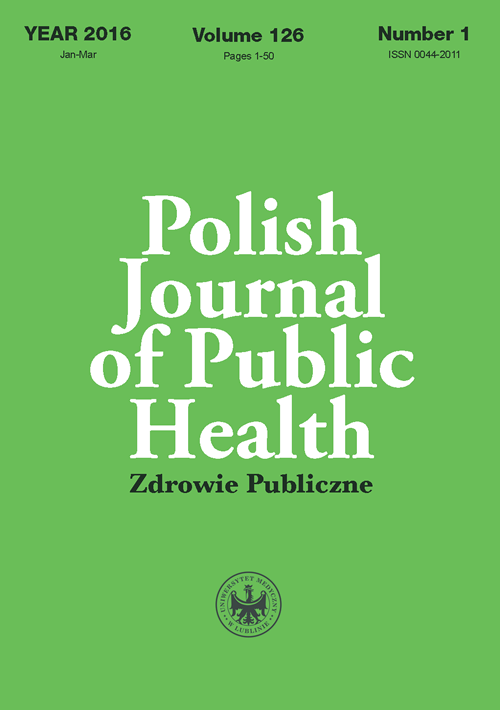Nursing care quality and post-operative wound infections
DOI:
https://doi.org/10.1515/pjph-2016-0003Słowa kluczowe:
prevention of hospital-acquired infections, postoperative wound infectionsAbstrakt
Introduction. The aim of the surveillance over infections is to define the critical points, lacks in knowledge or staff skills, as well as lack of equipment. It is aimed at preventing the same mistakes from being conducted all over again, instead of making those guilty suffer from consequences of their mistakes.
Aim. The authors aimed at assessing the quality of nursing care procedures in terms of preventing post-operative wound infections.
Materials and methods. The research was conducted in medical treatment, surgical and intensive care ward. A self-constructed questionnaire “Nursing care quality and prophylaxis of hospital-acquired infections” was used for the study. It was validated using the peer judges method.
Results and conclusions. The highest nursing care coefficient was noted in county hospitals (=94.5%), while the lowest was noted in clinical hospitals ( =91.3%). It was concluded that there is a deficit in adherence to procedures related to post-operative wound treatment.
Bibliografia
1. Fleischer M, Bober-Gheek B. Podstawy pielęgniarstwa epidemiologicznego. Warszawa: Centrum Kształcenia Podyplomowego Pielęgniarek i Położnych; 2006.
2. Dzierżanowska D. Zakażenia szpitalne. Bielsko-Biała: ά- medica press; 2008.
3. Heczko P, Wójkowska-Mach J. Zakażenia szpitalne; podręcznik dla zespołów kontroli zakażeń szpitalnych. Warszawa: Wyd. Lekarskie PZWL; 2009.
4. Jabłoński L, Karwat ID. Podstawy epidemiologii ogólnej, epidemiologia chorób zakaźnych. Lublin: Wydawnictwo Czelej; 2002.
5. Garus-Pakowska A, Szatko F, Pakowski M. Aspekty prawne odpowiedzialności zakładów opieki zdrowotnej za zakażenia szpitalne. Med Pr. 2009;60(4):335-43.
6. Anderson DJ, Chen LF, Sexton DJ, at al. Complex Surgical Site Infections and the Devilish Details of Risk Adjustment: Important Implications for Public Reporting. Infect Control and Hosp Epidemiol. 2008;29(10):234-9.
7. Astagneau P, Lhasriteau F. Surveillance of surgical-site infections: impact on quality of care and reporting dilemmas. Curr opin Infect Dis. 2010;23(4):306-10.
8. Casey AL, Elliott TSJ. Progress in the prevention of surgical site infection. Curr Opin Infect Dis. 2009;22:370-5.
9. Florman S, Nichols LR. Current approaches for the prevention of surgical site infections. Am J Infect Dis. 2007;3(1):51-61.
10. Wilson J, Wared VP, Coello R, at al. A user evaluation of the Nosocomial Infection National Surveillance System: surgical site infection module. J Hosp Infect. 2002;52:114-21. [CrossRef]
11. Leaper DJ, van Goor H, Reilly J, at al. Surgical site infection - an European perspective of incidence and economic burden. Int Wound J. 2004;1:247-73.
12. Graf K, Ott EE, Vonberg RP, at al. Surgical site infections-economic consequences for the health care system. Langenbecks Arch Surg. 2011;396:453-9.
13. Bulanda M, Tyski S, Ciuruś M. Zakażenia szpitalne w Polsce - stan wiedzy na kwiecień 2011. Raport programu „Stop Zakażeniom Szpitalnym. Program Promocji Higieny Szpitalnej”; 2011.
14. Centers for Disease Control and Prevention: Guidance on Public Reporting of Healthcare - Associated Infections. Recommendations of the Healthcare Infection Control Practices Advisory Committee; 2005.
15. Mangram AJ, Horan TC, Pearson ML, at al. The Hospital Infection Practices Advisory Committee. Guideline for prevention of surgical site infection 1999. ICHE. 1999;20(4):247-78.
16. Astagneau P, Lhasriteau F. Surveillance of surgical-site infections: impact on quality of care and reporting dilemmas. Curr opin Infect Dis. 2010;23(4):306-10.
17. Wójkowska-Mach J, Suetens C, Leat C, at al. Zakażenia miejsca operowanego w polskich szpitalach i europejskim programie HELICS. Zakażenia. 2005;2:70-3.
18. Pankin HT. Kontrola zakażeń w klinikach Europy - perspektywy i koncepcje poprawy jakości. Aseptyka. 2004;2:8-11.
19. Boer AS. Monitorowanie zakażeń miejsca operowanego w Holandii i Europie. Pielęg Epidemiol. 2003;7(15):13.
20. Wieder-Huszla S, Jurczak A, Grochans E, et al. Występowanie zakażeń wśród pacjentów po zabiegach operacyjnych przebywających w oddziale intensywnej terapii. Probl Hig Epidemiol. 2012;93(3):586-92.
21. Pierzchała K, Bogoniowska-Fahie A, Jakubowski A, et al. Porównanie wykrywalności zakażenia miejsca operowanego w metodzie biernej i czynnej rejestracji zakażeń szpitalnych. Zakażenia. 2003;4:15.
22. Reed D, Kemmerly SA. Infection control and prevention: a review of hospital-acquired infections and the economic implications. Ochsner J. 2009;9(1):27-31.
23. Pournoor J. Nowe narzędzia naukowe służące lepszemu zrozumieniu metod postępowania aseptycznego. Pielęg Epidemiol. 2004;4(19):9-12.
Pobrania
Opublikowane
Numer
Dział
Licencja
Prawa autorskie (c) 2016 Polish Journal of Public Health

Praca jest udostępniana na licencji Creative Commons Attribution-NonCommercial-NoDerivatives 3.0 Unported License.


